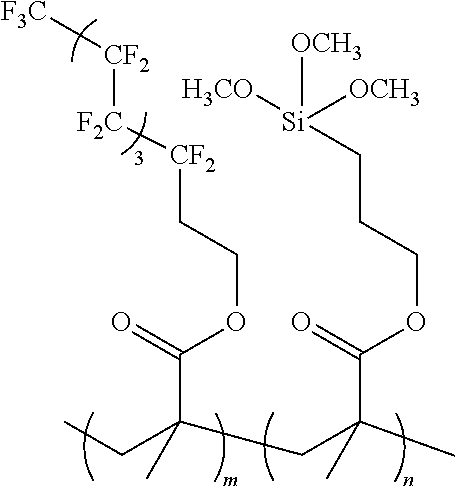Coated Articles With Improved Fingerprint Resistance and Methods of Making Same
a technology of fingerprint resistance and coating, applied in the direction of film/foil adhesive, coating, transportation and packaging, etc., can solve the problems of difficult application of these materials to a substrate, unsuitable application methods, non-transparent and/or hazy articles, etc., and achieve the effect of improving the resistance to adverse effects
- Summary
- Abstract
- Description
- Claims
- Application Information
AI Technical Summary
Benefits of technology
Problems solved by technology
Method used
Image
Examples
example 1
Fabrication of Adhesion Binders
[0061]A first adhesion binder was synthesized using the following procedure. About 2.67 grams (g) (about 0.005 moles (mol), based on a molecular weight of about 534) of a fluoroalkylmethyacrylate monomer that is commercially available under the trademark ZONYL was combined with about 1.25 g (about 0.005 mol, based on a molecular weight of about 250) of TMSMA (i.e., 3-(trimethoxysilyl)-propyl-methacrylate monomer) as well as about 10 milligrams (mg) (or about 0.0001 mol, based on a molecular weight of about 100) of azobisisobutyronitrile (“AIBN”), which is a thermal polymerization initiator, in about 10 milliliters (mL) THF in a 40 mL vial reaction vessel with an injection port and a stirrer bar. The reaction vessel was flushed with nitrogen, kept under nitrogen, and heated to about 70° C. for about 16 hours. Upon cooling to ambient or room temperature, the solution (which may be phase separated) was added to about 100 mL of ethanol and the resulting se...
example 2
Preliminary Evaluation of Adhesion Binder to Improve Durability
[0063]In this example, four sample sets of coatings were evaluated both qualitatively for coating durability / adhesion and quantitatively for coating hydrophobicity. The samples and procedures for making the samples are described below.
[0064]The substrates used for all sample sets were flat Corning GORILLA Glass sheets having a nominal composition of about 69.2 mol % SiO2, about 8.5 mol % Al2O3, about 13.9 mol % Na2O, about 1.2 mol % K2O, about 6.5 mol % MgO, about 0.5 mol % CaO, and about 0.2 mol % SnO2. In addition, for the sample sets where an adhesion binder was used, the adhesion binder was a random copolymer comprising 2-(perfluorooctyl)-ethyl-methacrylate and trimethoxysilylmethacrylate monomers (i.e., the second-described adhesion binder described in EXAMPLE 1). Finally, if a fluoropolymer was used, the fluoropolymer was a commercially available sample of TEFLON AF.
[0065]In general, each coating was spun-coated on...
example 3
Adhesion Binder Comparison between the Use of ZONYL and 2-(Perfluorooctyl)-Ethyl-Methacrylate as the Fluoroalkyl-Containing Monomer
[0078]The procedure described for preparing the samples of Group 3 of EXAMPLE 2 was used to evaluate the performance of the two different adhesion binders described in EXAMPLE 1. Based on the information available from DuPont, the fluoroalkyl methacrylate in the ZONYL samples was presumed to be a C8-based material that appeared to include a mixture of different fluoroalkyl methacrylates with the same average molecular weight as that described in the non-ZONYL adhesion binder of EXAMPLE 1.
[0079]The two adhesion binders performed (within experimental error) similarly in terms of TEFLON AF adhesion and coating mar resistance. With respect to hydrophobicity, however, the water contact angle for the coatings produced using the ZONYL-based adhesion binder was higher than the coatings produced using the non-ZONYL-based adhesion binder.
PUM
| Property | Measurement | Unit |
|---|---|---|
| thickness | aaaaa | aaaaa |
| haze | aaaaa | aaaaa |
| optical transmittance | aaaaa | aaaaa |
Abstract
Description
Claims
Application Information
 Login to View More
Login to View More - R&D
- Intellectual Property
- Life Sciences
- Materials
- Tech Scout
- Unparalleled Data Quality
- Higher Quality Content
- 60% Fewer Hallucinations
Browse by: Latest US Patents, China's latest patents, Technical Efficacy Thesaurus, Application Domain, Technology Topic, Popular Technical Reports.
© 2025 PatSnap. All rights reserved.Legal|Privacy policy|Modern Slavery Act Transparency Statement|Sitemap|About US| Contact US: help@patsnap.com


